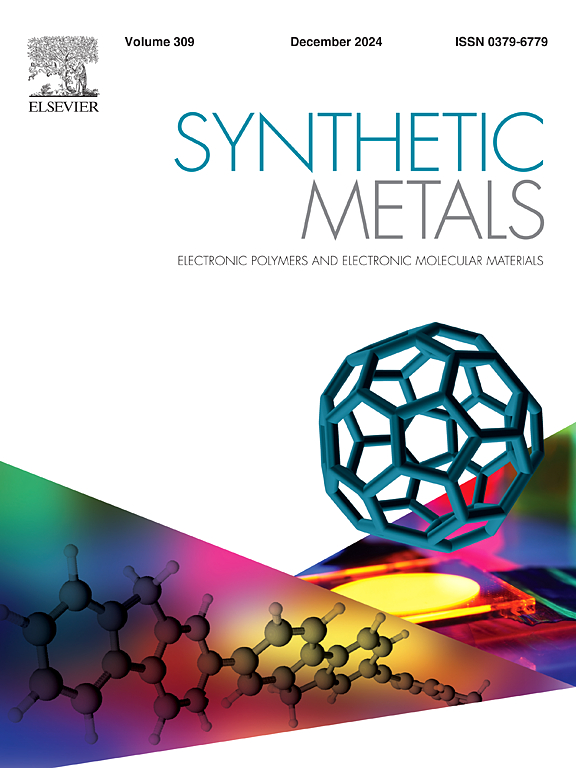Gamma-irradiated Chitosan@PVA@TiO2 catalytic counter electrodes for enhanced dye-sensitized solar cell (DSSC) performance
IF 4
3区 材料科学
Q2 MATERIALS SCIENCE, MULTIDISCIPLINARY
引用次数: 0
Abstract
Dye-sensitized solar cells (DSSCs) offer an affordable, versatile, and sustainable renewable energy solution, making them a valuable tool in combating climate change. From this standpoint, gamma irradiation treatment provides a viable approach to enhance the performance of low-cost, platinum-free counter-electrodes (CEs) by increasing the number of active sites, thereby improving their catalytic efficiency in DSSCs. To the best of our knowledge, for the first time, innovative Chitosan@polyvinyl alcohol@Titanium dioxide (Chitosan@PVA@TiO2) (CPT) hybrid films were developed as a catalytic CE substance and were subjected to a range of in-situ gamma irradiation doses (0, 10, 20, 30 and 40 KGy) with the goal to further improving their microstructural and physicochemical qualities. Coupled with a J–V variable evaluation, physical assessments of the microstructure, porosity, morphology, contact angle, optical, and electrochemical impedance spectroscopy (EIS) properties of CEs were carried out. The surface properties of the treated composites improved progressively with increasing gamma doses, reaching optimal levels at 30 KGy (i.e., apparent porosity = 72.5 %, average roughness (Ra) = 5.31 µm) compared to the pristine CE material. Prolonged gamma irradiation enhanced DSSC efficiency, achieving 6.45 % at 10 KGy and 7.14 % at 20 KGy. The high-energy gamma photons facilitated charge carrier movement within the CPT compounds while reducing recombination by creating conditions favorable for charge dissociation. Hence, improved mobility and reduced resistive limitations equate to longer lifespans and more efficient charge transfer within the solar cell. In this regard, the CPT catalytic CE's optimized yield of 8.57 % and short-circuit photocurrent density (Jsc) of 19.1 mA/cm2 were achieved after 30 KGy of modification of the surface. Compared to the pristine sample, effectiveness increased by 41.2 %. This enhancement in photovoltaic performance was attributed to the introduction of oxygen-enriched free radicals into the CPT structure, which created continuous channels for rapid electron transfer. Considering all aspects, this work highlights the critical role of gamma-irradiated CPT catalytic CEs in enhancing DSSC performance, offering a new approach to improving the efficiency of these devices.
γ辐照Chitosan@PVA@TiO2催化电极用于增强染料敏化太阳能电池(DSSC)性能
染料敏化太阳能电池(DSSCs)提供了一种价格合理、用途广泛、可持续的可再生能源解决方案,使其成为应对气候变化的宝贵工具。从这个角度来看,伽马辐射处理提供了一种可行的方法,通过增加活性位点的数量来提高低成本、无铂反电极(CEs)的性能,从而提高它们在DSSCs中的催化效率。据我们所知,首次开发了创新的Chitosan@polyvinyl alcohol@Titanium二氧化钛(Chitosan@PVA@TiO2) (CPT)杂化膜作为催化CE物质,并进行了一系列原位伽马辐射剂量(0、10、20、30和40 KGy),目的是进一步改善其微观结构和物理化学品质。结合J-V变量评价,对ce的微观结构、孔隙度、形貌、接触角、光学和电化学阻抗谱(EIS)性能进行了物理评价。随着γ剂量的增加,处理后的复合材料的表面性能逐渐改善,与原始CE材料相比,在30 KGy时达到最佳水平(即表观孔隙率= 72.5 %,平均粗糙度(Ra) = 5.31 µm)。长时间的伽马辐射提高了DSSC效率,在10 KGy时达到6.45 %,在20 KGy时达到7.14 %。高能伽马光子促进了CPT化合物内载流子的运动,同时通过创造有利于电荷解离的条件减少了复合。因此,提高移动性和减少电阻限制等同于更长的寿命和更有效的太阳能电池内的电荷转移。经过30 KGy的表面改性,CPT催化CE的优化产率为8.57 %,短路光电流密度(Jsc)为19.1 mA/cm2。与原始样品相比,有效性提高了41.2% %。这种光伏性能的增强归功于在CPT结构中引入了富氧自由基,这为快速电子转移创造了连续的通道。考虑到所有方面,本工作强调了γ辐照CPT催化ce在提高DSSC性能方面的关键作用,为提高这些设备的效率提供了一种新的方法。
本文章由计算机程序翻译,如有差异,请以英文原文为准。
求助全文
约1分钟内获得全文
求助全文
来源期刊

Synthetic Metals
工程技术-材料科学:综合
CiteScore
8.30
自引率
4.50%
发文量
189
审稿时长
33 days
期刊介绍:
This journal is an international medium for the rapid publication of original research papers, short communications and subject reviews dealing with research on and applications of electronic polymers and electronic molecular materials including novel carbon architectures. These functional materials have the properties of metals, semiconductors or magnets and are distinguishable from elemental and alloy/binary metals, semiconductors and magnets.
 求助内容:
求助内容: 应助结果提醒方式:
应助结果提醒方式:


